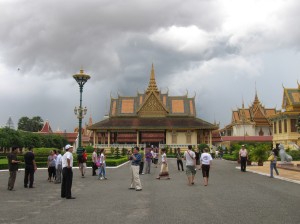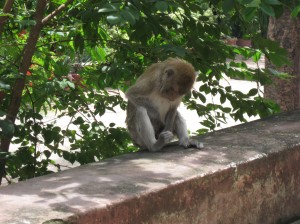
Now who would live in a house like this? The King of mother-lovin' Cambodia, that's who.
One of the first things that we see in Phnom Penh, as we wander along the banks of the Tonlé Sap River, is a young boy catching sparrows. With a snare attached to a long fishing pole he stalks them through the scrubby undergrowth, just a stone’s throw from the Royal Palace. Plucking them deftly one-by-one from the ground, he imprisons them in a cage with dozens of fellow feathered friends.
At first I assume that this must be for food. There’s not much meat on a sparrow, but there do seem to be plenty of desperately poor people in Phnom Penh. But then I start to have doubts: surely that fishing pole could be put to better use in the wide, muddy river that runs through the heart of the capital?
The next day, when visiting the city’s Wat Phnom Pagoda, all becomes clear. A man approaches us outside with a cage of little tweeters and offers to set one free for the sum of $1. “Good luck, good luck” he says. We politely decline. On the steps of the Wat, and all around the city, there are people who probably need a dollar much more than the birds do, and some good luck more than we do too; victims of landmines and war, the disabled, the vulnerable, children. One way or another, poverty is much more visible in Cambodia than in neighbouring Vietnam, the socialist system in the latter providing at least some kind of social safety net.
As we sit in the Foreign Correspondents’ Club later, I get the slightly uncomfortable feeling that we’re back in colonial times. Inside Europeans sit on the balcony sipping drinks and watching the world go by while outside – across the road in fact – poor children sit on the riverbank.
Despite its relative poverty, Phnom Penh is a fascinating place. It’s not the prettiest city in Asia by a long way, but there’s something about it that’s refreshingly down-to-earth and a little bit mysterious too. Go out at night in the city centre and you’ll be faced by an overwhelming darkness and stillness, punctuated here and there by the lights of government buildings and bars catering to foreigners and ex-pats. There are few cars on the road and few people in the street, and this after a decade of huge growth, economically and demographically.
In the mornings, we watched saffron-robed monks walk in small groups from shop to shop to beg for alms. In the cafés nearby we discovered not one but two excellent English language newspapers – The Phnom Penh Post and The Cambodia Daily – and a pretty good French language one – Le Cambodge Soir – too. How these papers are viable in a country of only 15 million people, most of them Khmer speakers, I couldn’t tell you.
The stories printed did not always inspire great faith in the government. In a typical week there was one about the forcible displacement of HIV positive slum-dwellers from the city to a camp in the countryside and another about the government’s angry reaction to a World Wildlife Fund report suggesting that the Irrawaddy river dolphin is nearing extinction in Cambodia (the WWF were telling ‘lies’ and the board should resign, the minister responsible said). But they did testify to the freedom of the press in this once rigidly-controlled country. Or at least, to the freedom of the foreign language press, which must have a fairly limited readership.

Some light relief: a monkey scratches himself inappropriately.
Back at Wat Phnom, an elephant was having its afternoon shower and a monkey was scratching itself inappropriately. We’d come here both to climb to the highest point in the city (erm, it’s not very high) and to see where the story of Phnom Penh began. The first pagoda was supposedly built here by one Lady Penh (‘Phnom Penh’ means ‘Penh’s hill’) in 1373 to house four golden Buddha statues that she found in a tree that washed ashore from the river. Inside the present day pagoda, at the top of the hill, a glittering and – dare I say it? – slightly gaudy selection of Buddhas sits on a dias, one with an electric space-age halo. The faithful come to pray and leave incense burning before the altar.
Later, we headed to the Central Market (Psar Thmei) for a good nose around the stalls and a bowl of noodle soup, before walking down to the Royal Palace, residence of King Norodom Sihanouk and his family. Much of it is off limits to the public but the bits that we did see, including the famous Silver Pagoda, were impressive, although not exactly restrained in their use of gold and diamonds to coat every available surface.
As a tourist, you can’t walk anywhere in central Phnom Penh without being offered a tuk-tuk ride every two minutes. “Do you want to see The Killing Fields, sir?” is a common refrain shouted by beaming tuk-tuk drivers. To see the horrors of Cambodia’s recent history transformed so quickly into tourist attractions is unsettling, but understandable – this is a poor country after all. As well as the Choeung Ek Killing Fields, 14 kilometres from town, you can also visit the notorious Tuol Sleng or S-21 Detention Centre where, under the Khmer Rouge, 12 000 people were tortured before being executed. I didn’t have the inclination or the stomach to go to the place. One can only hope that the people who do behave as they would at Belsen or Auschwitz.
Indeed it’s strange when travelling around Cambodia to think that anyone you meet who’s over 30 somehow managed to survive that time, when around 1 ½ million people out of a population of 7 million were murdered or died from starvation, slave labour and disease. What’s all the more remarkable is what a friendly, happy bunch of people the Cambodians seem to be today. Almost everywhere we went we were greeted with a wide, warm smile. It seems that the woolly humanist conclusion is the correct one here: when a country has been through so much horror, its people truly appreciate all the things that we rich foreigners take for granted – peace, enough to eat, and a roof over your head.
But I don’t speak Khmer, so I couldn’t say for sure.
Your comments about the contrast between the horrors of the Khmer Rouge years and the sweet nature of Cambodians is an odd disconnect that I noticed too. We returned from our first trip in June, loved Angkor but especially enjoyed Phnom Penh and Battambang.
Hi Scott. Thanks for taking a look at the ‘blog. It sounds like you did almost exactly the same trip as me. We started in P.P., then went to Angkor (Siem Reap) and Battambang. My thoughts on the last two places will be in my next post.
Thanks for this article. Phnom Penh is a very best place to see. They attract thousand of tourist national as well as international. You can see Royal Palace, Silver Pagoda, buddha is situated in the center of the silver pagoda. Must visit National Museum near Royal palace, Cambodian art, Thunder Ranch, Cheoung Ek Mekong Island, Phnom Chiso, Koh Dach, prasat Neang Khmao, Oudong, Angkor Borei.For more details refer http://www.travelworth.com/places-of-tourist-interest-in-phnom-penh.html